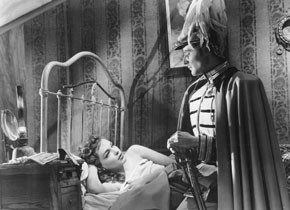Max Ophüls
May 8 to June 13, 2010
One of Marcel Ophüls’ favorite stories about his father concerns an anti-fascist radio program broadcast during World War II: no matter how tough a day he had, Max Ophüls always arrived at the recording studio on time that evening to sing the Nazis their lullaby – but instead of counting sheep he listed their crimes, which were daily growing by the thousands. The fascists were tuned in, so the radio answered back – letting Ophüls know they knew where to find him, “that Jew Oppenheimer.” This was in France, just before the Nazis overran the country forcing the Ophüls family to flee once again. The German exile, born as Max Oppenheimer in Saarland in 1902, had only recently become a French citizen; next stop was the USA.
Ophüls already had ten productive years of theater and radio work in the Weimar Republic when he joined the pantheon of cinema in the early 1930s: just one year after his film directing debut he achieved worldwide success with his first masterpiece Liebelei (1933), adapted from the Schnitzler play. The imprint of his theater and radio experiences is obvious in Ophüls’ films: the fascinating way in which sound takes on a life of its own, or his interest in the mechanics of show business, and the manifold sequences that deal with watching (a spectacle) and being watched. Still, film represented something completely different for Ophüls, a new art form which gave him a crucial ability: to put the gaze in motion. Max Ophüls is synonymous with a camera that slips, slides, strolls and swirls: it desperately rushes up a staircase and plunges out the window (Le Plaisir); it celebrates the solemn ceremony of a funeral throughout the rooms and halls of a palace (De Mayerling à Sarajevo); it skips lightly with the hero through glowing scenery, on the run yet confident of victory – and weightless (The Exile).
For Ophüls, this constant movement is key: it characterizes his aesthetic, his central theme (the circulation of goods and relationships), and his restless personal life. Two weeks after the premiere of Liebelei, a melodrama of unrequited love and lost illusions, he fled Germany, a country that had already abandoned him. The films that followed were created in flight; in Italy (another masterpiece: La signora di tutti, 1934), the Netherlands (Komedie om geld, 1936) and especially in France, where despite anti-German sentiment Ophüls quickly established himself with some of his finest films, Yoshiwara (1937), Werther (1938) and Sans lendemain (1939). In 1941, he arrived in California, but he would never really feel at home there. The forlorn titles of his films during that period seem to reflect his state of mind: The Exile; Letter from an Unknown Woman; Caught; The Reckless Moment. These are four terrific and unusual Hollywood films from a man who was not cut out for Hollywood; they seem ‘torn from’ rather than ‘emerging from’ the system.
Ophüls was a merchant’s son, a fact that would shape his work in several ways. His films revolve around money and possessions, objects decide between life and death, and the ‘exchange rate’ of human emotions is calculated in ironic and desperate tales of love and ever-present social arrangements which cripple their participants, in both body and soul. Ophüls himself also fell victim to the “rules” of middle-class business ideology, being regularly accused of squandering the resources of his producers. Yet he knew precisely what the problem was: cinema, said Ophüls, was “a perpetual struggle between truly beautiful goods [schönen guten Waren] and the True--the Beautiful--the Good. [dem Wahren-Schönen-Guten]” His seemingly slow working methods and visual style earned him a reputation for extravagance, even when he stayed on budget. He didn’t trust producers and refused to adapt to a certain “film industry lifestyle” – especially while in the U.S.
In 1949 Ophüls returned to France and to his artistic kin, Arthur Schnitzler; La Ronde (1950) also gave him his ‘ideal’ actor (Adolf Wohlbrück) – and thus helped cement his reputation as the most ‘Viennese’ among the giants of cinema (even though he was not even Austrian). His renewed fame following La Ronde, and the three final masterworks in his career – Le Plaisir, Madame de ... and Lola Montez – are also partly responsible for Ophüls’ place in film history today: a creator of essential cinema.
Thus, from the vantage point of 2010, it is difficult to comprehend his precarious position in 1957, the year of his death: Lola Montez, his opus magnum, the sum of his life’s work, had been met with icy disdain by the film industry and its allies in the popular press. Rather than delivering sex and scandal as demanded by the producers “in the name of the public,” Ophüls had turned his epic into something else entirely. In Lola Montez, the theater of life is celebrated in all its unbridled joy and illusion-shattering coldness, in screaming color and stylized widescreen tableaus. Lola stands in the circus arena, the object of spectacle and cinema-scopic desire, revolving on a turntable, turning in a circle, as her life passes her by. Max Ophüls sets the camera in motion and begins to make his own revolution, but instead of following her he turns in the opposite direction, the only way to create friction, a spark, a pause: against time.
In addition to the films of Max Ophüls, the Film Museum presents a selection of his radio work, including the famous radio-play “Novelle” from 1954, and two lectures by Alexandra Seibel (Vienna) and Ronny Loewy (Frankfurt am Main). The retrospective is part of the Vienna Festival (Wiener Festwochen) and generously supported by ERSTE BANK.
Related materials
